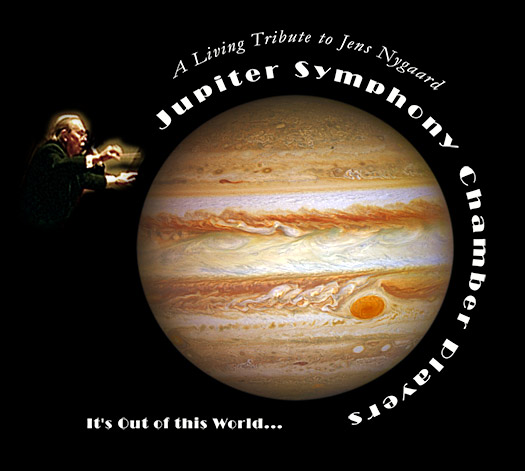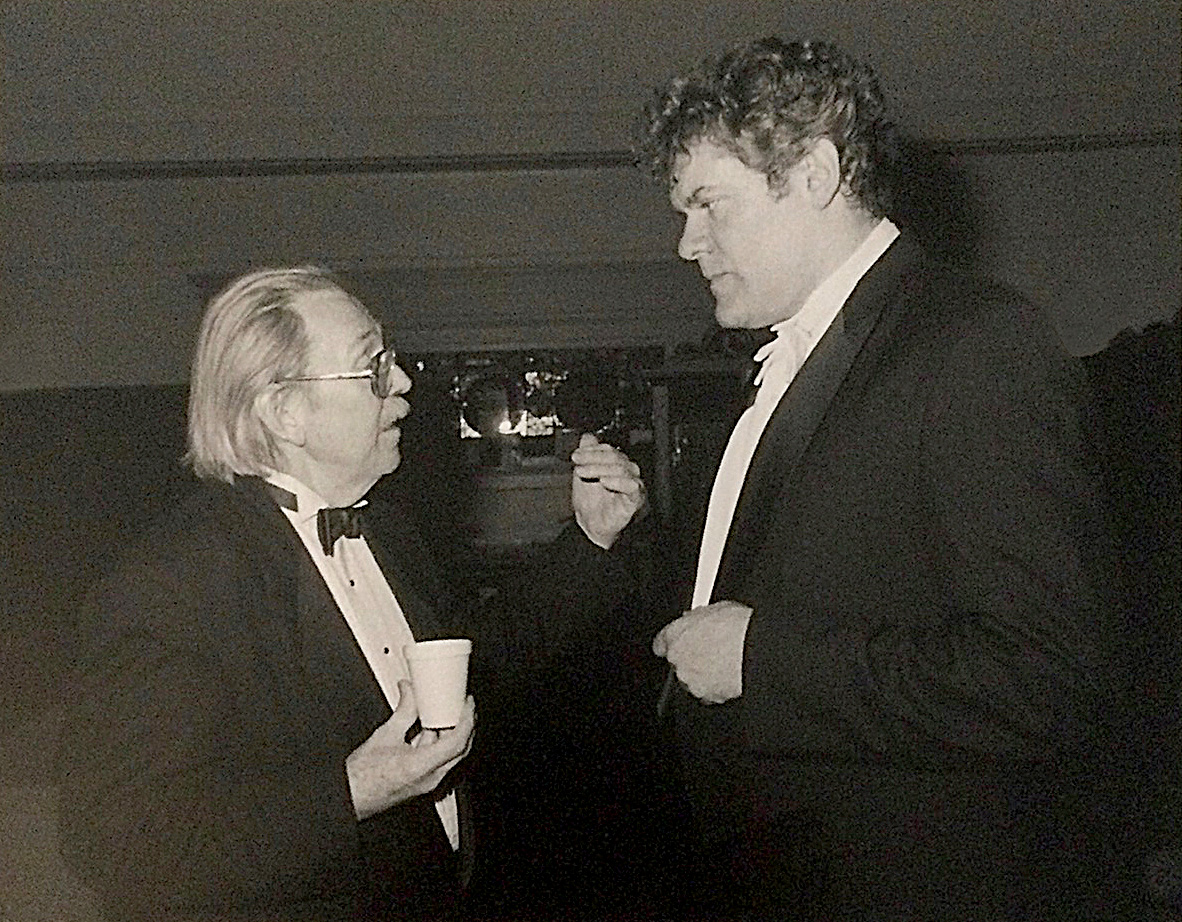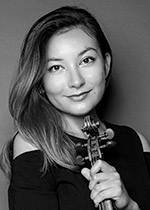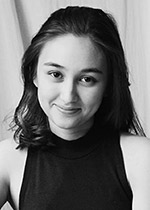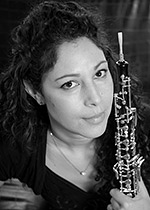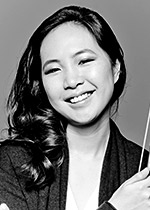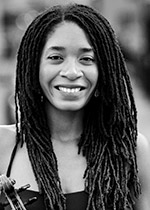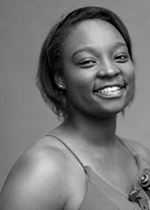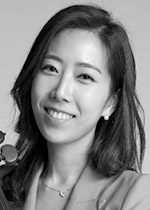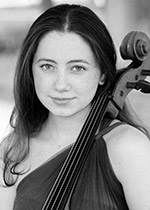Join us for our next concerts...
Monday, April 29 ♦ 2 PM & 7:30 PM
Folk Roots
Good Shepherd Presbyterian Church
152 West 66 Street (west of Broadway)
Limited Seating
Tickets: $25, $17, $10 ~ Reservations advised
Call (212) 799-1259 or email admin@jupitersymphony.com
Pay by check or cash (exact change)
Avery Gagliano piano
Winner of the First Prize and Best Concerto Prize at the 2020 National Chopin Piano Competition, other winnings include the Audience Prize at the 2019 Cliburn Junior Piano Competition, and First Prize at both the Aspen Concerto and MostArts Piano competitions ~ “...a compelling presence at the piano. She immediately draws you in… She has the technique and the musicianship, which is the ultimate combination of a young artist.” National Public Radio ~ From the Top
Itamar Zorman violin
Recipient of the 2013 Avery Fisher Career Grant ~ winner of the 2011 Tchaikovsky
and 2010 Freiburg competitions ~ “a
virtuoso of emotions” Göttinger Tageblatt ~ “I cannot believe my ears... such musical originality, a tone full of colors and beauty and an emotional expression full of inner intensity” Hanoch Ron ~ Yedioth Aharonot (Israel's largest newspaper)
Paul Neubauer viola
First
violist to win an Avery Fisher Career Grant, first prize winner of the
Whitaker, D’Angelo and Lionel Tertis competitions ~ “Neubauer’s
seamless control of the bow, his intonation, his rich and varied tonal
palette, mark him as a member of the elite.” The New York Times
Isabelle Durrenberger violin
Fellow of Ensemble Connect’s 2023–2025 seasons, semifinalist at the 2022 Indianapolis Competition, and 3rd Prize at the 2018 Irving Klein String Competition
Christine Lamprea cello
First Prize winner of the Sphinx and Schadt competitions, winner of the 2013 Astral Artists’ Auditions and recipient of an award from the National Foundation for Advancement in the Arts ~ praised by the Boston Musical Intelligencer for her “supreme panache and charmingly effortless phrasing”
Nina Bernat double bass
Won First Prize at the 2019 International Society of Bassists Solo Competition; recipient of the 2019 Keston MAX Fellowship
Anthony Trionfo flute
A winner of the 2016 Young Concert Artists Auditions, won first prize at the 2013 Alexander & Buono competition, and a winner of the National YoungArts Foundation competition ~ “spellbinding” Santa Barbara Voice
Roni Gal-Ed oboe
First Prize winner of the Lauschmann Oboe Competition in Mannheim ~ “Outstanding” The New York Times ~ “Expressive, wonderful player” German SZ Magazine
Vadim Lando clarinet
Winner of the CMC Canada, Yale and Stonybrook competitions ~ “consistently
distinguished...vibrant, precise, virtuosic playing” The New York Times
Karl Kramer horn
Winner of the 1997 and 1999 American Horn
competitions ~ “a prominent, perilously chromatic horn line, which Karl Kramer played beautifully.” The New York
Times
Gina Cuffari bassoon
Co-principal Bassoonist of the Orpheus Chamber Orchestra, praised for her “sound that is by turns sensuous, lyric,
and fast moving” Palm Beach Daily News
William Grant STILL Miniatures
~ a charming suite by the “Dean of African American Composers”—arranged for wind quintet by Adam Lesnick in 1996 from the original for flute, oboe, and piano
The unique suite of five miniatures is drawn from Afro, Anglo, Latino, and native musical styles, and was dedicated to the eminent conductor Sir John Barbirolli and his wife Lady Evelyn Barbirolli, as a souvenir of their visit to America. The movements are “I ride an old paint,” an American cowboy song; “Adolorido,” a Mexican folk song; “Jesus is a rock in the weary land,” an American spiritual; “Yaravi,” a Peruvian folk song; and “A frog went a-courtin’,” an American folk song.
Still (1895–1978) was the first Black American to have a symphony played by a leading orchestra, the first to conduct a major orchestra, the first to have an opera performed by an important company, and among the first to write for radio, film, and television. Born in Woodville, Mississippi, his father was the town bandmaster. After his death the family moved to Little Rock, Arkansas, where he began studying the violin, and where he and Florence Price were classmates in elementary school. He enrolled at Wilberforce College intending to study medicine but left without graduating as he turned to music instead and was influenced by Coleridge-Taylor. He worked with various music groups, including W. C. Handy’s band in 1916. He then went to Oberlin Conservatory, where his teachers encouraged him to compose, but World War I interrupted his studies. After his service in the navy, he returned to Oberlin, then worked for Handy’s publishing company in New York, played the oboe in theater orchestras, studied on a scholarship with Edgard Varèse, and began to write large-scale works in the early 1920s. In 1923 George Chadwick urged him to write American music; one result was his Afro-American Symphony, which the Rochester Philharmonic performed in 1931. “Still became best known for his nationalist works, employing negro and other American folk idioms. After a period of avant-garde experiment he turned in a neoromantic direction, with graceful melodies supported by conventional harmonies, rhythms and timbres; his music has a freshness and individuality that have brought enthusiastic response [New Grove Dictionary].”
Florence PRICE Piano Quintet in A minor
~ engaging in its beautiful post-Romantic harmonic language, and unmistakably inspired by African-American spirituals, folk tunes, ragtime, and the rhythmic juba dance from the slave plantations of the Deep South
In 1893, a year after arriving in the United States, Dvořák urged American composers to look to their own folk music for inspiration, advising through the New York Herald, “The future music of this country must be founded upon what are called the Negro melodies. This must be the real foundation of any serious and original school of composition to be developed in the United States.” Price was then only 6, but had already given her first public piano recital the year before. Her compositions, influenced by Dvořák, reveal that she followed his advice. The music publisher Barbara Garvey Jackson has said that Price’s “methods are actually quite close to Dvořák’s in the way she approaches the use of ethnic materials (both of the Old and the New Worlds).”
Price (1887–1953) was the first Black woman to have her work performed by major American orchestras. She was born into a middle class family in Little Rock, Arkansas, and was first taught music by her mother when white instructors refused to do so. Since women of color in the South were denied advanced training, after she completed high school in 1903 at age 16, her mother enrolled her at the New England Conservatory, where she studied the organ, piano, pedagogy, and other music disciplines (her composition teacher was the director George Chadwick). Having earned 2 artist diplomas, Price began her career as an instructor at segregated schools in Arkansas, then as head of the music department at Clark University in Atlanta until 1912. Returning to Little Rock, she managed a private piano studio, composed pedagogical music for children, married, and raised 2 daughters. However, in 1927, a brutal lynching and financial difficulties hastened the family’s move to Chicago. This move resulted in a burst of creativity, competition wins, and widespread recognition for her work beginning in the 1930s. The Chicago Symphony Orchestra performed her Symphony in E minor in 1933, and collaborations with Marian Anderson and Leontyne Price followed.
Antonín DVOŘÁK String Quintet No. 2 in G Major Op. 77
~ flush with sonorous harmonies and poignant, seductive melodies evocative of Bohemian folk music, the “Double Bass” Quintet is among his finest works—with the Intermezzo (Andante religioso) movement, as was originally written
Scored for string quartet and double bass, the luscious Quintet was written after he had rebuffed his youthful enthusiasm for Wagner and embraced Bohemian music. The masterwork won a prize at the Artistic Circle’s competition as well as lavish praise.
|
|
Monday, May 13 ♦ 2 PM & 7:30 PM
Russian Splendor
Good Shepherd Presbyterian Church
152 West 66 Street (west of Broadway)
Limited Seating
Tickets: $25, $17, $10 ~ Reservations advised
Call (212) 799-1259 or email admin@jupitersymphony.com
Pay by check or cash (exact change)
Adam Golka piano
Winner of the 2008 Gilmore Young Artist Award and the 2009 Max Allen Award of the American Pianists Association “brilliant technique and real emotional depth” The Washington Post
Danbi Um violin
Top prize in the 2018 Naumburg competitions; Recipient of the 2018 Salon di Virtuosi Career Grant; Winner of the 2015 Astral Artists Auditions; Silver Medalist in the Menuhin and Michael Hill competitions ~ “...utterly dazzling” The Strad ~ “a marvelous show of superb technique” and “mesmerizing grace” New York Classical Review
Njioma Grevious violin
Founding member of the Abeo Quartet ~ grand prizewinner of the 2023 Concert Artists Guild and Young Classical Artists Trust auditions, first prize at the 2023 Sphinx and 2018 Prix Ravel (France) competitions, and a fellowship from the Music Academy of the West to study with the London Symphony Orchestra in 2022 ~ described by the Chicago Classical Review as “a superb” talent
Milena Pajaro-van de Stadt viola
Winnings include First Prize at the 2013 Banff Competition, Gold Medal and Grand Prize at the 2010 Fischoff Competition, First Prize at the Lionel Tertis Viola Competition, and top prizes at the Tokyo and Sphinx competitions ~ “she
should have a great future” Tully Potter ~ Wigmore Hall ~ “lyricism that stood out...a silky tone and beautiful, supple lines” Strad Magazine
Kevonna Shuford viola
A vibrant musician, she has performed with ensembles such as the Boston Philharmonic, Atlantic Symphony, and Palaver Strings; and she has appeared as an artist at the Great Lakes Chamber Music Festival, St. Lawrence String Quartet Seminar, Encore Chamber Music Program, and Meadowmount School of Music
Christine Lee cello
Member of the Boston Symphony Orchestra ~winner of the Isang Yun competition as well as a laureate of the Queen Elizabeth first cello competition in 2017
Bethany Bobbs cello
Winner of numerous prizes, including the grand prize at the Houston Symphony of the North Young Artist competition, first prizes in the Houston MTA Concerto Competition, New Jersey MTNA Senior String Competition, and Georgia Philharmonic Concerto Competition, and an award at the National YoungArts Competition
Vadim Lando clarinet
Winner of the CMC Canada, Yale and Stonybrook competitions ~ “consistently
distinguished...vibrant, precise, virtuosic playing” The New York Times
Note: Danbi Um replaces Jennifer Frautschi for this concert
Theodor LESCHETIZKY Souvenir de Venise Op. 4
~ a Barcarolle—traditionally a folk song sung by Venetian gondoliers, with a gently rocking rhythm—for solo piano
Leschetizky (1830–1915) was the most influential piano teacher (along with Liszt) of his time. He studied with Carl Czerny (Beethoven’s pupil), and by age 14, he was already in great demand as a teacher. In 1852 he moved to St. Petersburg, where he soon attracted numerous students, and was invited to appear before the Tsar. He became a close friend of Anton Rubinstein, occasionally stepping in for him as teacher and conductor, and in 1862, at Rubinstein’s request he became director of piano studies at the Conservatory. In 1878 he returned to Vienna and private teaching. He also toured Russia, Poland, and Germany, and was regarded as one of the great pianists of the Romantic era; he had a formidable technique and an infallible ear. His teaching continued the school of Czerny, which he modified, stressing a thorough understanding of the music, absolutely sound technique, and, above all, beauty of tone. Among his most famous pupils were Paderewski, Artur Schnabel, and Ignaz Friedman. He had 4 wives (not at the same time).
Anton ARENSKY Piano Trio No. 2 in F minor Op. 73
~ infused with Russian romanticism, the fine Trio reveals his expert compositional skills and artistry as a master melodist in one of his last works—a dark and brooding movement is followed by a Chopinesque Romance, capricious Scherzo, and expansive variations on a noble theme
A pupil of Rimsky-Korsakov at the St. Petersburg Conservatory, Arensky graduated with a gold medal in 1882. He then became one of the youngest professors ever to teach at the Moscow Conservatory—harmony and counterpoint. Among his pupils were Rachmaninoff and Scriabin. The move to Moscow brought him in close contact with Sergei Taneyev and Tchaikovsky, who gave him much practical encouragement. Both composers influenced Arensky’s compositions. One of his best-known pieces is the Variations for string orchestra on a theme from Tchaikovsky’s famous Legend; it is an arrangement of the slow movement of his String Quartet No. 2, which he dedicated to Tchaikovsky in his memory. His 6 Pieces Op. 5 were dedicated to Taneyev. Tchaikovsky’s correspondence also affirms the friendship of the 3 composers. A letter from late March or early April 1884, for example, summons Arensky “to descend from the majestic Kokorevskian and Arenskian heights to No. 14 on the lower floor of your dwelling on Saturday, the day after tomorrow, to the undersigned at 8 o’clock in the evening. 3 quartets by Mozart will be performed. The audience shall be Taneyev, Laroche, Huber, you, and P. Tchaikovsky.” At the time Tchaikovsky was living in room No. 14 on the ground floor of the Kokorevsky Courtyard Hotel, several floors below Arensky. Born in Novgorod in 1861, Arensky died from tuberculosis in 1906 in Terijoki, Finland (then part of the Russian Empire), most likely exacerbated by his drinking. He was only 44.
Sergey TANEYEV Canzona in F minor
~ lyrical and expressive, originally for clarinet and orchestra
The Canzona was extremely popular in Russia, so much so that Taneyev arranged it for clarinet and piano, and for cello and piano, respectively. It became a favorite of Mstislav Rostropovich, who recorded it in 1964 with his pianist colleague Alexander Dedyukhin.
Taneyev (1856–1915) came from a cultured family with aristocratic connections. He was given his first piano lessons at age 5, and from the age of 9 to 18, he studied at the Moscow Conservatory. Among his teachers were Tchaikovsky (in composition) and Nikolai Rubinstein (in piano). He became a brilliant pianist, graduating in 1875 with a gold medal in composition and performance—the first in the history of the Conservatory to achieve this honor. Taneyev became close friends with Tchaikovsky and was held in such high regard that Tchaikovsky sought and appreciated his opinions and musical suggestions. He was trusted with giving the first Russian performance of Tchaikovsky’s First Piano Concerto, as well as performing as soloist for the Russian premieres of Tchaikovsky’s other works for piano and orchestra. In 1878, upon Tchaikovsky’s resignation, Taneyev was persuaded to take his teacher’s place, but he consented only to teach the harmony and orchestration classes. In 1885 he reluctantly became the Conservatory’s director. Among his pupils were Rachmaninoff, Scriabin, and Glière. At his death from a heart attack in 1915, he left a large body of work including 4 symphonies, keyboard and choral works, and many chamber pieces. Taneyev has been called the “Russian Brahms” and he may also be a “Russian Bruckner.” Tchaikovsky had even dubbed him the “Russian Bach” as Bach was one of his early inspirations.
TCHAIKOVSKY Souvenir de Florence Op. 70
~ emotional intensity in a breathtaking soundscape—for string sextet It all began in Florence, a city he loved and visited several times, and where he made his first sketches. From conception to finish, however, took more than 5 years. On 28 June 1887, Tchaikovsky noted in his diary: “Composed a little.” A few days later, on 2 July, he reported to Mikhail Ippolitov-Ivanov, “I jotted down sketches for a string sextet, but with little enthusiasm... I haven’t the slightest inclination to work….” After the intervention of other compositions and distractions, he told his brother Modest on 27 June 1890, “I began it three days ago and am writing with difficulty, not for wont of new ideas, but because of the novelty of the form. One requires six independent yet homogeneous voices. This is unimaginably difficult.” When the original version was completed, Souvenir was played at a private concert in Tchaikovsky’s apartment at the Hotel Rossiya probably on 2 December 1890, and again on the 10th—its first public performance—at the Saint Petersburg branch of the Russian Musical Society. Dissatisfied, he withdrew the piece for revisions and structural alterations. On 15 June 1891, in a letter to Ippolitov-Ivanov, Tchaikovsky expressed his intention to “radically alter the string sextet, which turned out to be astonishingly bad in all respects.” He was finally happy with the revised version, which was performed with Leopold Auer leading on 6 December 1892 at the Russian Musical Society. Elated, Tchaikovsky wrote to Modest, “What a Sextet—and what a fugue at the end—it’s a pleasure! It is awful how pleased I am with myself; I am embarrassed not by any lack of ideas, but by the novelty of the form.” |
Jupiter 2022 - 2023 Season
20 Mondays at 2:00 PM & 7:30 PM
Good Shepherd Church ♦ 152 West 66 Street
View
Our Season Calendar
Tickets: $25, $17, $10 ~ Reservation advised
Call (212) 799-1259 or email admin@jupitersymphony.com
Pay by check or cash (exact change)
Please visit our Media Page to hear Audio Recordings from the Jens Nygaard and Jupiter Symphony Archive
Concert Venue:
Good Shepherd Presbyterian Church
152 West 66 Street (west of Broadway), New York
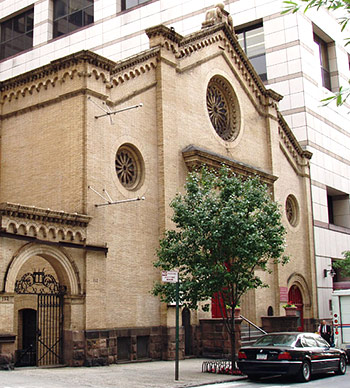
“one of the most refined and intelligent church spaces in New York” ~ The New York Times
Built in 1893 by Josiah Cleveland Cady, architect of the old Metropolitan Opera House and the American Museum of Natural History
|
Office Address:
JUPITER SYMPHONY
155 West 68th Street, Suite 319
New York, NY 10023
admin@jupitersymphony.com
(212) 799-1259
 
Like our Facebook page to see photos, videos,
concert information and the latest news
Jupiter in the News
ConcertoNet
“knocked the socks off this listener...It was wondrous chamber music. And the three artists gave it the deserving excitement, volition and imagination.”
Harry Rolnick, ConcertoNet more...

“the performers were top notch”
“The homey church where these concerts take place, nestled on West 66th Street in the shadow of Lincoln Center, is an intimate and acoustically vibrant place for chamber music.”
Anthony Tommasini, The New York Times more...
Strad Magazine
“A finely forthright, fluent and expressive account of Haydn's Divertimento in E-flat major opened this programme of miscellaneous chamber music in a series known for adventurous programming.”
Dennis Rooney, Strad Magazine more...
ConcertoNet
“Mr.
Nygaard’s cadenza flowed down Mozart lanes and paths, each with
beautiful backgrounds. And at the very end, Mr. Nygaard brought forth
that martial major theme, like an unexpected gift.”
Harry Rolnick, ConcertoNet more...
|
As promised, here are the videos of John Field’s Divertissement No. 1 and Sir Hamilton Harty’s Piano Quintet. Fortuitously, our Jupiter musicians had the good sense to record the rehearsal in an impromptu decision, literally minutes before pressing the record button. Pianist Mackenzie Melemed (replacing Roman Rabinovich at the last minute) learned the music in 2 days! Bravo to him.
Both works are Irish rarities that were scheduled for the March 16 performances which had to be canceled because of the coronavirus epidemic. Even though the entire program could not be recorded because of technical issues, we are pleased to be able to share with you the 2 musical gems. Enjoy.
John FIELD Divertissement No. 1 H. 13
~ simply delicious piano quintet, alternately titled Rondeau Pastoral and better known in its version for solo piano, Twelve O’clock Rondo, on account of the 12 “chimes” at the end ~ by the creator of the Nocturne, which had a major influence on Chopin
We thank the University of Illinois (Champaign) for a copy of the Divertissement music.
Mackenzie Melemed piano
Abigel Kralik violin
Dechopol Kowintaweewat violin
Sarah Sung viola
Christine Lamprea cello
Sir Hamilton HARTY Piano Quintet in F Major Op. 12
~ in a lyrical Romantic idiom, with a distinct, breezy Irish-salted voice
Andrew Clements of the Guardian proclaimed the beautiful Quintet “a real discovery: a big, bold statement full of striking melodic ideas and intriguing harmonic shifts, which adds Brahms and Dvořák into Harty’s stylistic mix, together with Tchaikovsky in some passages.” There’s folk music charm as well, reminiscent of Percy Grainger—notably in the Scherzo (Vivace) with its folksy quirks and nonchalance, and the winding, pentatonic melody in the Lento.
Our gratitude to the Queen’s University Library in Belfast, Northern Ireland, for a copy of the autograph manuscript of the music. Much thanks, too, to Connor Brown for speedily creating a printed score and parts from Harty’s manuscript.
Mackenzie Melemed piano
Abigel Kralik violin
Dechopol Kowintaweewat violin
Sarah Sun viola
Christine Lamprea cello
I Allegro 0:00
II Vivace 10:43
III Lento 14:44
IV Allegro con brio 23:59
|

Oliver Neubauer violin, Mihai Marica cello, Zoe Martin-Doike viola
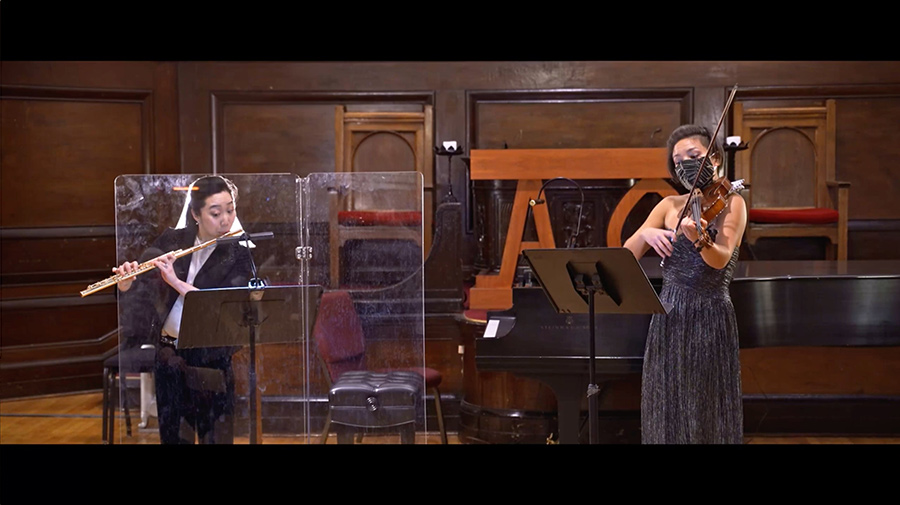
Sooyun Kim flute, Zoe Martin-Doike viola
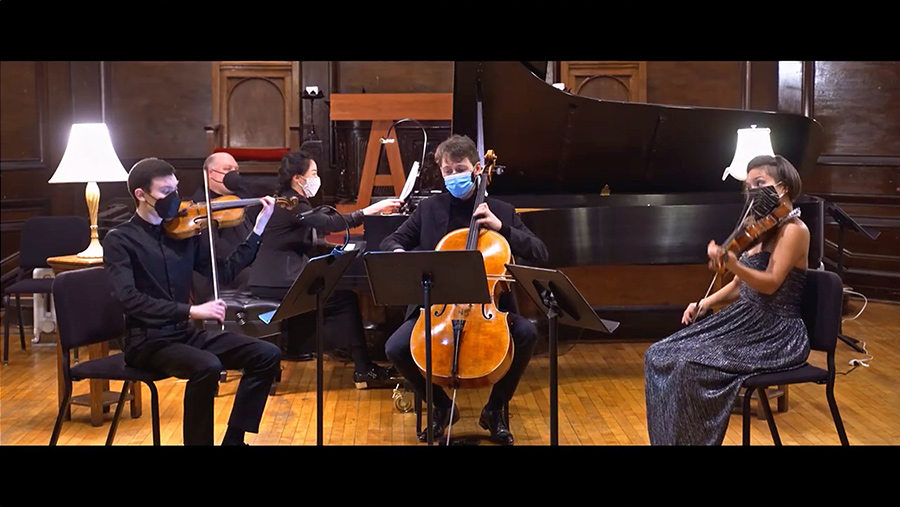
Oliver Neubauer violin, Janice Carissa piano
Mihai Marica cello, Zoe Martin-Doike viola
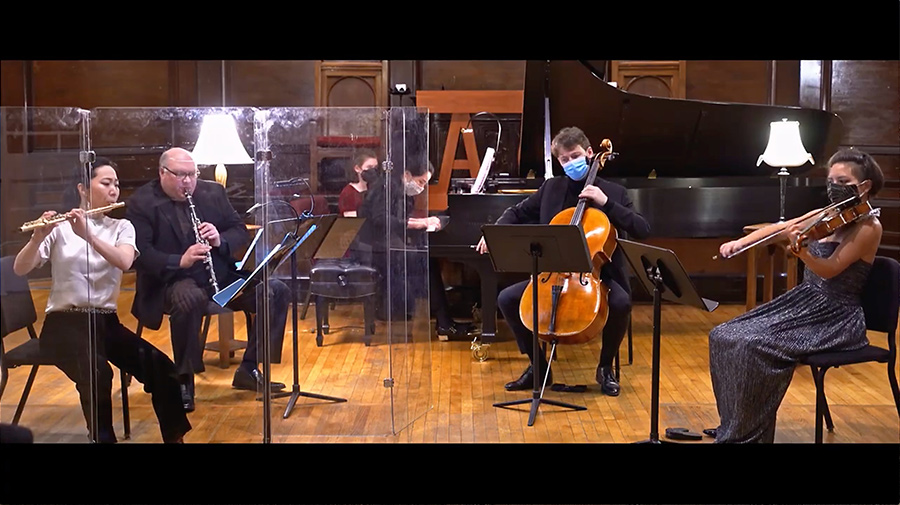
Sooyun Kim flute, Vadim Lando clarinet, Janice Carissa piano
Mihai Marica cello, Zoe Martin-Doike viola
|
Video Viewing ~ Classical Treats
February 8, 2021 Jupiter Concert
Greetings! Three months ago, our musicians brought warmth and joy with their wonderful music making on a cold, winter’s day with Classical Treats. The viewing is offered for $25, and we hope to cover the costs of production. Thanks so much for viewing the video of this concert, and for supporting Jupiter with gifts as well! MeiYing
View the video for $25
You will be automatically directed to the video page once payment is made. If not, click on the “return to merchant” link after checkout. Please go through the checkout process only once and do not use the back button or reload the page while making the purchase. If there are any problems, contact jupiternews@jupitersymphony.com.
Viewers comments of previous videos:
“Oh I thoroughly enjoyed the concert. Good to see Maxim and his dad. Familiar faces to me. I enjoyed the notes about the players. Till the next time...”
“Great playing and really nice camera work. Probably better than being there!”
“We so enjoyed the concert. The pianist was outstanding as was the musical selection.”
“It was wonderful. Thank you.”
♦ ♦ ♦
Musicians
Janice Carissa piano
Young Scholar of the Lang Lang Foundation, recipient of the 2018 Salon de Virtuosi Grant, winner of the 2014 piano competition at the Aspen Festival, and a top prizewinner of the IBLA Foundation’s 2006 piano competition (at age 8)
Oliver Neubauer violin
Recipient of the Gold Award at the 2018 National YoungArts Competition and winner of the 2017 Young Musicians Competition at the Chamber Music Society of Lincoln Center
Zoë Martin-Doike viola
Member of the Metropolitan Opera Orchestra, top prizewinner of the Primrose and Lenox competitions on viola and violin, respectively and founding violinist of the Aizuri Quartet
Mihai Marica cello
Winner of the Irving Klein, Viña del Mar, Salon de Virtuosi and Dotzauer competitions ~ “Mihai is a brilliant cellist and interpreter of music. His playing is spellbinding.” Mitchell Sardou Klein
Sooyun Kim flute
Winner of the Georg Solti Foundation Career Grant and a top prize at the ARD flute competition, she has been praised for her “vivid tone colors” by the Oregonian and as a “rare virtuoso of the flute” by Libération
Vadim Lando clarinet
Winner of the CMC Canada, Yale and Stonybrook competitions ~ “consistently
distinguished...vibrant, precise, virtuosic playing” The New York Times
♦ ♦ ♦
Program
HAYDN Sonata No. 1 in G Major Hob XVI:40 ▪ 1784
~ sophisticated and subtly wrought, the Sonata is from a set of 3, arranged for string trio from the original for keyboard and published by Johann André in 1790
The sonatas were written for Princess Marie, the new bride of Prince Nicholas Esterházy, grandson of Haydn’s employer, Prince Nicholas I. Cramer’s Magazin der Musik, in its review in 1785, observed that they were “more difficult to perform than one initially believes. They demand the utmost precision, and much delicacy in performance.” In 2 contrasting movements, the pastoral Allegretto innocente is followed by a gleeful zany romp.
Conradin KREUTZER Quintet in A Major ▪ between 1810 and 1820
~ in the late Classical–early Romantic style, the charming Quintet is written for the unusual combination of piano, flute, clarinet, viola, and cello with the piano as primus inter pares, first among equals—each movement a winner bearing a variety of melodic gifts and revealing a lively feeling for rhythm and color
Born in Messkirch to a respected Swabian burgher, Kreutzer (1780–1849) is considered a minor master of the Biedermeier epoch. He studied law in Freiburg before turning entirely to music after his father died in 1800. In 1804 he went to Vienna, where he met Haydn and probably studied with Albrechtsberger, one of Beethoven’s teachers. His active career included tours in Europe and several posts in Vienna, Stuttgart, Cologne, and other German cities, all the while composing numerous operas. Some of his music is not entirely forgotten—his settings for male chorus to Ludwig Uhland’s poems long remained popular with German and Austrian choirs; Das Nachtlager in Granada used to be revived occasionally in Germany; and his score for Der Verschwender continues to be performed in Austria.
Franz Anton HOFFMEISTER Duo Concertante No. 1 in G Major ▪ [1790]
flute and viola
1st movement ~ Allegro
~ by Mozart’s friend and his principal publisher
MOZART Piano Quartet No. 2 in Eb Major K. 493 ▪ 1786
~ a flawless masterpiece of utmost lightness and charm, with heavenly melodies
Mozart was under contract with the publisher Franz Anton Hoffmeister to write 3 piano quartets, a virtually new genre of his own invention. When the first (K. 478 in G minor) did not sell because of its difficulty for amateurs, Mozart was released from his obligation. Nine months later, which was two months after the completion of Le Nozze di Figaro, the second piano quartet (K. 493 in Eb Major) was published by Artaria. A little easier than the first, Alfred Einstein viewed it as “bright in color, but iridescent, with hints of darker shades.”
♦ ♦ ♦
Harry Munz audio engineer
Marc Basch videographer
For more about the musicians: guest artists • players
For further notes on the music: calendar |
|
